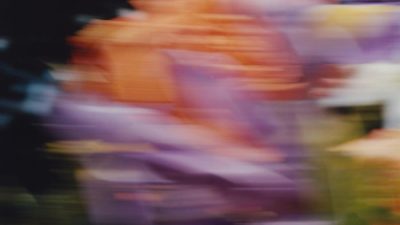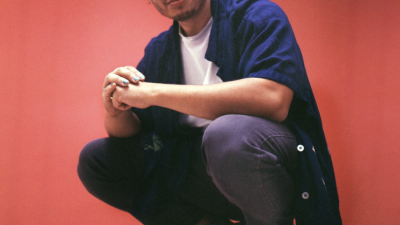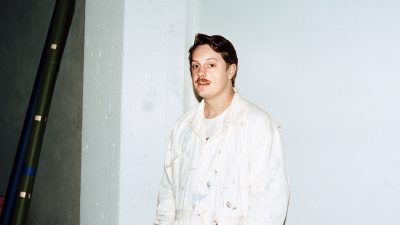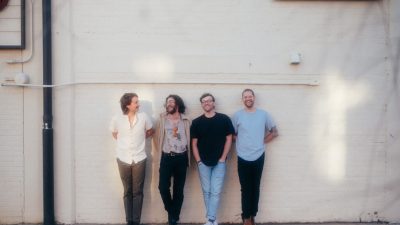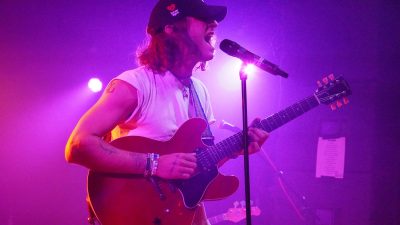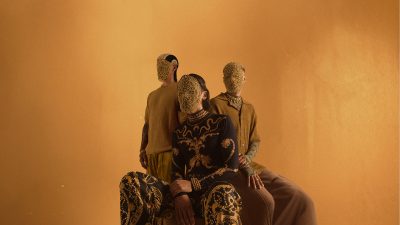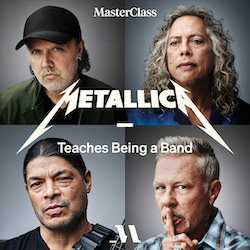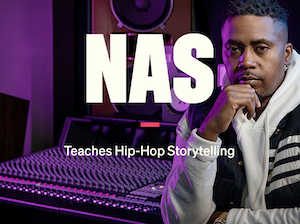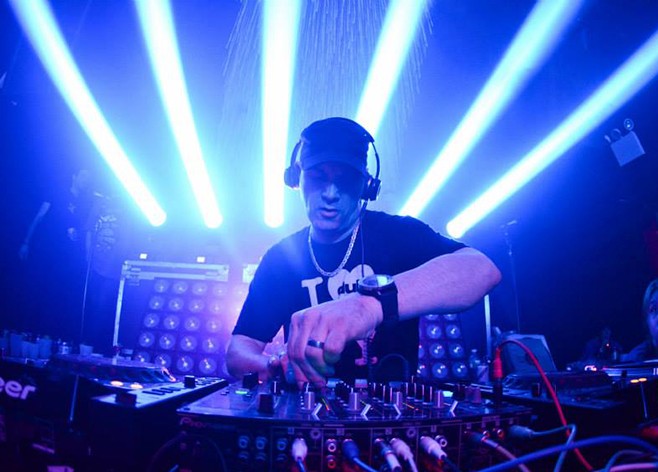
By ways of intro. There are many things that distinguish the Brooklyn Electronic Music Festival from other festivals that keep growing like Taylor Swift’s exes. Venue is the first key difference. Unlike Lollaplooza’s Grant Park or Coachella’s desert, BEMF doesn’t have a lot of space partitioned off for its own purposes. The festival instead takes place inside the city, within eight clubs along Wythe and Kent avenues in Williamsburg, Brooklyn.
With just two streets to wander about, it’s not a flurry-fuck for visitors to know where things are. In fact, compared to the arbitrary spread of stages in the giant grounds that most festivals are on, this is a welcome turn of events. It’s also a great way for people familiar with Williamsburg to become especially intimate with these two popular streets, and the unique world of each of BEMF’s eight venues. This area used to be all warehouses, and each of the venues have kept (and exploited) their exposed brick foundations.
The musical offerings are wide. The promoters aim to have something to please everyone—retired raver, hipster on the lookout for unique ways to fiddle with music, scene kids—and they definitely succeeded. For festivalgoers, the trick to enjoying BEMF seems to be finding the venue that carries your kind of music. More experimental house and trance could be found at Villain and Glasslands. Party boy (and girl) music was at Verboten and Music Hall of Williamsburg. Kinfolk and Cameo Gallery held more “chill out” music.
The audience is distinct at each venue as well. Glasslands seemed to be home to the burn-outs. Verboten welcomed the pushy dance kids. Cameo and Villain encouraged retired ravers, current professionals with J Crew shoes and 350 dollar skirts; at Cameo they drank neat scotch and Villain they had PBRs. Music Hall of Williamsburg had kids asking adults to buy them alcohol (and during an interview with Chris Malinchak, this is exactly what happened). Some places had 70 percent men, others had close to 90 percent men.
Each venue is its separate world, and the chance to step into whichever one you please is the real treat of BEMF.
Villain. If you want innovation (which tends to make the most exciting music) Villain had your back. Usual early acts are politely ignored, but Deru 1979 (stage name of Benjamin Wynn; joined by Effix) was a welcome exception. With a BA in Music Technology, Wynn is one of the more learned DJs at BEMF. He combined classical, hip-hop, electronic and world music to capture the audience with visuals and audio. The two DJs played in the middle of two screens. They played slow action shots of NYC that interacted with music waves, the kind you’d see in physics class. The scenes interacted with themselves and the music, creating an impressive visual display that was all too rare at BEMF. It’s a shame more people didn’t turn out (though it was early for the raver world—he went on at 8pm). But the 30 or so people who made it were completely mesmerized.
Saturday night’s highlight was Lee Bannon. The Sacramento DJ’s debut album, Alternate/Endings was a beautiful house base punctuated with thoughtful elements of trance. At times, the percussive elements were mind-blowing. Saturday night it held some of the best music and the best looking yuppies you can imagine, all armed with a PBR and designer leather boots. Bannon’s only downside to the live performance is that he basically ignored the audience, rarely looking up and never changing tempos to accommodate the few brave dancers who burst into the middle on occasion. This self-reservation is common to a lot of DJs, but when you’re performing and people pay 20-25 dollars, it seems like you should put on a show—to quench the bar chatter if for no other reason.
Output. Whereas Villain with its small stature greatly exceeded expectations, Output, one of Brooklyn’s top dance clubs, was a big disappointment. NYC DJ, Cranks, performed in the Panther Room. It’s a pity this solid musician had little opportunity for a worthwhile audience. Some 10-15 people sat along the room’s perimeter, in the shadows, nodding their head. The walls of Output are not the friendliest. It’s the only venue that doesn’t allow photos (a mantra various signs chant as you walk through the building), and a four-dollar coat check is required; water is five dollars. The cover to see this local musician is 20 dollars. To call this ridiculously overpriced is generous. For some reason this was the same price to see more established acts like Todd Edwards and Route 94, acts that probably deserved a less sleazy venue.
Verboten. Along with Deru 1979, The Renegades of Rhythm (Cut Chemist and DJ Shadow) were one of the few to complement their impressive performance with a greater dizzying display of graphics. Queen, James Brown, Lipps Inc were all smashed together into a happy go-lucky mix. Hip-hop was of course a cornerstone, with plenty of shout outs to Afrika Bambaataa. “She’s still going strong!” DJ Shadow said of a 1987 percussion machine featured throughout the act.
The only downside to their performance was the venue. With a popular event like this, sliding in was basically impossible to see either DJ. It’s ironic that BEMF gave some of their most accomplished musicians so little space to for the audience to enjoy their music. It was somewhat a mystery that the venue charged $55 to see “The Renegades of Rhythm” when they played at Irving Plaza days before for $35. True to New York’s seedier side, the venue seemed to want to make more money then keep its patrons safe or happy.
Cameo Gallery. If you can grab a spot, the Boiler Room Production is everything it’s cracked up to be. Whereas Glasslands and Villain were high mountains, Cameo was heaven. DJ Scotto controlled lighting, and contributed a memorable set before Love & Logic came on at 1am. DJ Frankie Bones brought an energetic set complemented by a beautiful light design.
The audience had the posh hipsters expected at a Boiler Room broadcast. But it also had its share of ravers who refused to retire or dance calmly. One came for the name, and one came for the music; it was lively to see the dichotomous groups squished together under one roof.
Surprisingly, the next night, Cameo was drained of all energy. DJ Dave P had great chill out music, but it didn’t justify a live performance. The music transitioned without him as he spent a good midnight opening up a vodka bottle. Cameo was beautiful while it lasted.
Glasslands has a history of ADHD crowds. 70 percent of the audience didn’t face the stage, instead talking about God knows what. Two tall men at the front of the stage spent the entire concert acting like bouncers as they cast their eye across the audience. Pinch (Rob Ellis) was just as oblivious toward the audience as they were to him. He leaned over his three sets of turntables, grazing them like a fascinated archaeologist brushing away dust on the way to his find.
Music Hall of Williamsburg. BEMF’s largest venue understandably held some of the bigger acts. Galantis played Friday night, and with their ever-fun music, delivered to the people what they paid for.
Shift k3Y and Billon were basically interchangeable: Under the legal drinking age DJs with a dependency on their Mac Books and still in the shadow of Daft Punk. Though generic, they did their job at increasing heartbeats before one of the night’s headliner, pop artist Little Boots. By the time an agonizing set up was complete, 30 minutes had passed since her scheduled time, and neither the set up nor the extended wait could justify the performance. Though her songs are as well written and catchy as those she’s often compared to (Ladyhawk, Robyn) she is not as strong a vocalist live. That, and a festival when lyrics aren’t expected to exist, made the performance lackluster.
By ways of conclusion. While more DJs should engage with the audience to justify a live performance, most don’t (with the exception of Gaslamp Killer, Galantis, and Cut Chemist/DJ Shadow). Unless they have some visual show, most of the time you are getting a ticket to a curated club night.
If you plan to see three or more acts, festival passes proved to be the way to go. Tickets to individual events were anywhere from 20 to 55 dollars. Unless you’re a trust fund baby, it isn’t worth to see most of these DJs live for that much money; unless you get a pass.
BEMF is a great way to become part of the city. These string of former warehouses form a sort of dance district. The venues, all small to medium sized, are perfect for electronic music. More people will undoubtedly hop on board in the coming years.
Image, Boiler Room set, courtesy of Brooklyn Electronic Music Festival




